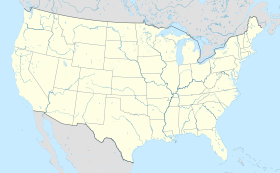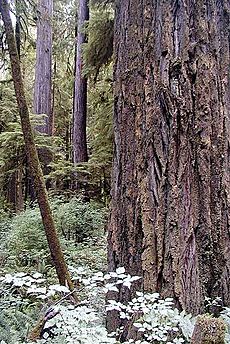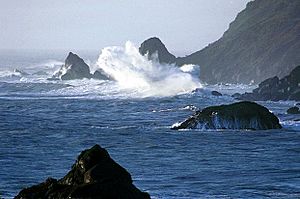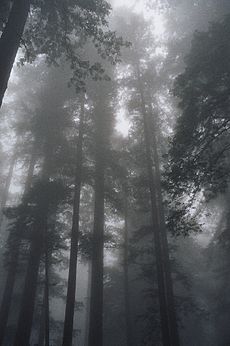Redwood National and State Parks facts for kids
Quick facts for kids Redwood National and State Parks |
|
|---|---|
|
IUCN Category V (Protected Landscape/Seascape)
|
|
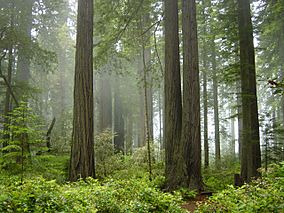
A forest of coast redwoods in fog
|
|
| Location | Humboldt County & Del Norte County, California, US |
| Nearest city | Crescent City |
| Area | 139,091 acres (562.88 km2) |
| Established | October 2, 1968 |
| Visitors | 458,400 (in 2022) |
| Governing body | National Park Service and California Department of Parks and Recreation |
| UNESCO World Heritage Site | |
| Criteria | Natural: (vii), (ix) |
| Inscription | 1980 (4th Session) |
The Redwood National and State Parks (RNSP) are a group of parks along the coast of northern California. They include one U.S. national park and three California state parks. These parks are Redwood National Park, Del Norte Coast Redwoods State Park, Jedediah Smith Redwoods State Park, and Prairie Creek Redwoods State Park.
Together, the parks cover about 139,000 acres (560 km2). They protect 45 percent of all the remaining old-growth coast redwood forests. Old-growth forests are ancient forests that have not been cut down by people.
These parks are in Del Norte and Humboldt counties. They protect the endangered coast redwood (Sequoia sempervirens). This tree is the tallest, one of the oldest, and one of the biggest tree species on Earth. It grows well in the wet, mild rainforest climate.
The park area often has earthquakes and can have tsunamis. The parks also protect 37 miles (60 km) of beautiful coastline. They are home to native plants, animals, grasslands, rivers, and important cultural sites. They also protect threatened animals like the Chinook salmon, northern spotted owl, and Steller's sea lion.
Long ago, redwood forests covered over two million acres (8,100 km2) of the California coast. The area where the parks are today stayed wild until after 1850. The gold rush brought many European-Americans. They started a big timber business, cutting down trees and pushing Native Americans aside.
For many years, people cut down trees without limits. This was called clear-cut logging. Later, people started working hard to protect nature. In the 1920s, the Save the Redwoods League helped create state parks like Prairie Creek, Del Norte Coast, and Jedediah Smith Redwoods State Parks.
After groups like the Save the Redwoods League and the Sierra Club asked for help, the U.S. Congress created Redwood National Park in 1968. They made it bigger in 1978. In 1994, the National Park Service (NPS) and the California Department of Parks and Recreation joined Redwood National Park with the three state parks next to it. They now work together to manage them as one area. Today, the parks try to protect and bring back the coast redwood forests to how they were before 1850. This includes using controlled burning to help the forest.
In 1980, the United Nations named these parks a World Heritage Site. This was because of their rare ecosystem and important history. In 2023, local Native American tribes created an Indigenous Marine Stewardship Area. This helps protect the park region, coastline, and ocean waters.
You can visit the parks for free, except for special permits. Visitors can camp, hike, bike, and ride horses on about 200 miles (320 km) of trails.
Contents
How the Parks Are Managed
Redwood National and State Parks include Redwood National Park, which is run by the U.S. Government's National Park Service (NPS). It also includes Jedediah Smith, Del Norte Coast, and Prairie Creek Redwoods State Parks, which are run by the California Department of Parks and Recreation (CDPR). All these parks are managed together.
The main office for Redwood National Park is in Crescent City, California. There are five visitor centers where you can get information and learn about the park. These include the Hiouchi, Jedediah Smith, Prairie Creek, and Thomas H. Kuchel visitor centers. There is also the Crescent City Information Center at the park headquarters.
Amazing Nature in the Parks
The Redwood National and State Parks are a very important protected area. They are part of the Northern California coastal forests region.
Plants and Trees
It is thought that old-growth redwood forests once covered nearly 2 million acres (8,100 km2) of coastal northern California. Sadly, 96% of these old-growth redwoods have been cut down. Almost half (45%) of the redwoods that are left are found in Redwood National and State Parks.
The parks protect 38,982 acres (157.75 km2) of old-growth forest. This land is split almost equally between federal (U.S. government) and state management. Redwoods have lived along the northern California coast for at least 20 million years. They are related to tree species that lived 160 million years ago.
The coast redwood naturally grows from the northern California coast up to the southern Oregon Coast. It is closely related to the giant sequoia in central California. It is also related to the dawn redwood from China.
Coast redwoods are the tallest trees on Earth. As of September 2006, the tallest tree in the park was Hyperion at 379.1 feet (115.6 m) tall. Other very tall trees are Helios at 376.3 feet (114.7 m) and Icarus at 371.2 feet (113.1 m).
Before 2006, the tallest known tree was the Stratosphere Giant. It was outside the park in Humboldt Redwoods State Park. It was 370 feet (110 m) tall in 2004. Another tree called Tall Tree in Prairie Creek Redwoods State Park was 367.8 feet (112.1 m) tall. But its top 10 feet (3.0 m) died in the 1990s. One tree that fell in 1991 was reported to be 372.04 feet (113.40 m) tall.
Only the giant sequoia has more wood by weight. The largest redwood by volume is the Lost Monarch. It is 42,500 cubic feet (1,205 m³) and is in Jedediah Smith Redwoods State Park.
Mature Coast redwoods usually live 500–700 years. Some are known to be 2,000 years old. This makes them some of the longest-living things on Earth. They are very good at fighting off diseases. This is because of their thick bark and high amount of tannin. Redwoods like to grow on sheltered hillsides, a bit inland, and near water like rivers and streams.
Redwood trees grow huge branches that collect deep soil. Other tree-sized trunks can grow on these branches. This usually happens above 150 feet (46 m) high. Scientists have found that plants that usually grow on the forest floor also grow in this high-up soil. These soil mats are home to invertebrates, mollusks, earthworms, and salamanders.
During dry seasons, some treetops might die back. But the trees do not die completely. Instead, redwoods can grow new trunks from other branches. These new trunks are called reiterations. They also grow roots in the soil collected at their bases. This helps bring water to the very top of the trees. Coastal fog also provides up to one-third of the water they need each year.
Another large tree in the forest is the coast Douglas-fir. It can grow over 300 feet (91 m) tall. Sitka spruce trees are common along the coast. They can handle salty air better than other trees. The evergreen hardwood tanoak produces a nut like the acorns from oak trees. Both tanoaks and oaks are in the beech family. Other common trees are the Pacific madrone, bigleaf maple, California laurel, and red alder.
Huckleberry, blackberry, and salmonberry bushes grow under the taller trees. They provide food for many animals. The California rhododendron and azalea are flowering bushes common in the park. This is especially true in old-growth forests. Plants like the sword fern grow a lot, especially near water. In Prairie Creek Redwoods State Park, Fern Canyon is a famous ravine. It is 30 to 50 feet (9.1 to 15.2 m) deep, and its walls are completely covered in ferns.
Animals and Their Life Cycles
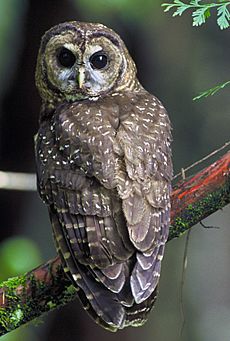
The ecosystems in RNSP protect many rare animal species. The park has different areas like the seacoast, rivers, prairies, and thick forests. The tidewater goby is an endangered species that lives near the Pacific coastline. The bald eagle, which usually builds nests near water, is an endangered species in California. The Chinook salmon, northern spotted owl, and Steller's sea lion are some other animal species that are threatened.
Over 40 types of mammals live here. These include the black bear, coyote, cougar, bobcat, beaver, river otter, and black-tailed deer. Roosevelt elk are the easiest large mammals to see in the park. Their groups have grown back from almost disappearing in the area. They are now common in park areas south of the Klamath River. Many smaller mammals live high up in the forest canopy. Different types of bats, like the big brown bat, and other small mammals, like the red squirrel and northern flying squirrel, spend most of their lives high above the forest floor.
Along the coast, California sea lions, Steller sea lions, and harbor seals live near the shore. They also live on seastacks, which are rocky islands just off the coast. You might sometimes see Dolphins and Pacific gray whales offshore. Brown pelicans and double-crested cormorants are mostly found on cliffs along the coast and on seastacks. Sandpipers and gulls live along the coast and inland.
Inland, birds that need freshwater include the common merganser, osprey, red-shouldered hawk, great blue heron, and Steller's jay. At least 400 bird species have been seen in the forestlands.
Reptiles and amphibians also live in the parks. The northwestern ringneck snake, northern red-legged frog, Pacific giant salamander, and the rough-skinned newt are the most commonly seen.
Plants and Animals That Don't Belong
More than 200 types of plants and animals that are not native to Redwood National and State Parks now live there. Of these, 30 are considered invasive species. Ten of these 30 are seen as threats to the local species and ecosystems. Plants that are not native make up about a quarter of all the plants in the parks.
In old-growth areas, only about one percent of plant growth is from non-native species. But in areas like the Bald Hills prairies, 50 to 75 percent of the plants are not native. The types of foreign plants also change. Examples include English Ivy (Hedera helix), Spotted Knapweed (Centaurea maculosa), and Poison Hemlock (Conium maculatum). The spotted knapweed and poison hemlock are being considered for a high-priority watch list by the park system.
Earth's Movements and Features
The northern coast of California, including RNSP and the ocean nearby, has the most earthquake activity in the U.S. Small earthquakes happen often in the park and under the Pacific Ocean. These quakes cause rivers to change paths, landslides, and cliffs along the sea to wear away.
The North American, Pacific, and Gorda Plates are tectonic plates that all meet at the Mendocino Triple Junction. This spot is only 100 miles (160 km) southwest of the parks. In the 1990s, more than nine earthquakes stronger than magnitude 6.0 happened along this fault zone. These caused one death and a lot of money loss. There is always a chance of a major earthquake. The park makes sure visitors know about this risk through pamphlets and signs. The danger of a tsunami is also a big worry. Visitors near the coast are told to go to higher ground right after any strong earthquake.
Both the coastline and the Coast Ranges are inside the park. Most of the rocks in the parks are part of the Franciscan Assemblage. These rocks were pushed up from the ocean floor millions of years ago. These sedimentary rocks are mostly sandstone, siltstone, shale, and chert. There are also smaller amounts of metamorphic rocks like greenstone.
These rocks usually wear away easily. You can see them along the coast and where rivers and streams have cut small canyons. They formed during the Cretaceous Period and are very changed from being pushed up and folded. In some areas, rivers have created deposits of sand, mud, and gravel. These are carried into the park from upstream. Redwood Creek follows the Grogan Fault. On the west side of the creek, you can find schist and other metamorphic rocks. On the east side, there are sedimentary rocks from the Franciscan Assemblage.
Weather and Climate
The Redwood National and State Parks have an oceanic temperate rainforest climate. This means it has cool summers like a Mediterranean climate. The weather in RNSP is very much affected by the Pacific Ocean.
Coastal temperatures are usually between 40 and 60 degrees Fahrenheit (4–15 °C) all year. Further from the coast, summers are hotter and drier, and winters are colder. Redwoods mostly grow one or two miles (1.5–3 km) from the coast. They never grow more than 50 miles (80 km) from it. In this mild but wet coastal area, the trees get moisture from heavy winter rains and constant summer fog.
The presence of summer fog is actually more important for the trees' health than heavy rain. This is shown by the yearly rainfall, which can be between 25 and 122 inches (64 and 310 cm). Healthy redwood forests grow even in areas with less rain. This is because the constant summer fog and cooler temperatures help reduce their need for a lot of water. Snow is rare, even on peaks above 1,500 feet (460 m). This shows how mild the weather is here. However, light snow mixed with rain is common during the winter months.
Managing Wildfires
Wildfires are a natural part of most land ecosystems. Nature has adapted to fire in many ways. Not having fires can often be bad for the environment. Wildfires remove dead plants and trees. This makes the soil richer and helps healthier trees get more nutrients.
Controlled fires are now part of the park's fire management plan. These fires help remove non-native species of plants. They also create a more fertile and natural ecosystem. Fire is also used to protect prairie grasslands. It keeps forests from growing into them, making sure there is enough land for elk and deer. Oak forest areas also benefit from controlled burns. Without them, Douglas fir trees would eventually take over and reduce the variety of life.
In old-growth redwood areas, using fire reduces dead material. This helps prevent larger redwoods from dying by removing plants that compete with them. The park has a fire management plan that watches all fires, weather patterns, and the amount of dead plant material. This dead material is removed from areas near buildings and where fire could be dangerous to people. Controlled burns are used in other areas. The National Interagency Fire Center provides more firefighters and equipment if a large fire happens.
Fun Things to Do
The park has three visitor centers. Here you can find guided nature walks and general information. There are also two other information points. Unlike most other national parks in the U.S., you do not pay a fee to enter Redwood National and State Parks.
The DeMartin Redwood Youth Hostel, a simple shared place to stay near Klamath, has now closed. There are no hotels or motels inside the park boundaries. However, nearby towns like Klamath, Requa, and Orick have small hotels and inns. You can find many more places to stay in the bigger towns of Crescent City to the north and Arcata and Eureka to the south. The park is about 260 miles (420 km) north of San Francisco. It is about 300 miles (480 km) south of Portland, Oregon. U.S. Route 101 goes through the park from north to south. The Smith River National Recreation Area, which is part of the Six Rivers National Forest, is next to the north end of RNSP.
The state parks have campsites where you can drive your car. Each campground offers campfire talks during the summer. They also have guided tours. The parks have many picnic areas that you can reach by car. In the federal parts of the park, hiking is the only way to reach campsites in the wilderness.
These wilderness campsites are at Mill Creek campground in Del Norte Coast Redwoods State Park and Jedediah Smith campground in Jedediah Smith Redwoods State Park, which together have 251 campsites. The Elk Prairie campground in Prairie Creek Redwoods State Park has 76 campsites. The Gold Bluffs Beach campground has 25 campsites. Other state parks nearby also have campsites you can drive to.
Camping in the wilderness requires a permit. It is only allowed in special spots, except on gravel bars along Redwood Creek. Access to the wilderness is carefully controlled. This prevents too many people from using it while still letting many groups explore the forest. So, camping in the wilderness is limited to five nights in a row. You can camp for a total of 15 nights in any one year.
You must store your food properly to avoid problems with bears. Hikers and backpackers must take out any trash they create.
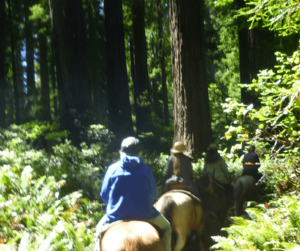
There are almost 200 miles (320 km) of hiking trails in the parks. But during the rainy season, some temporary footbridges are removed. This is because high water would destroy them. Throughout the year, trails are often wet. Hikers need to be ready for rainy weather. They should also check with information centers for updates on trail conditions.
Horseback riding and mountain biking are popular. But they are only allowed on certain trails. Kayaking is popular along the coast and in the rivers and streams. Kayakers and canoeists often travel the Smith River. This is the longest river in California that does not have a dam.
Fishing for salmon and steelhead is best in the Smith and Klamath rivers. Steelhead are a type of rainbow trout that swim from the ocean to freshwater to lay eggs. They are highly valued and can be over 16 inches (41 cm) long. You need a California sport fishing license to fish in any of the rivers and streams. Hunting is not allowed anywhere in the parks. But it is allowed in nearby National Forests.
Related pages



